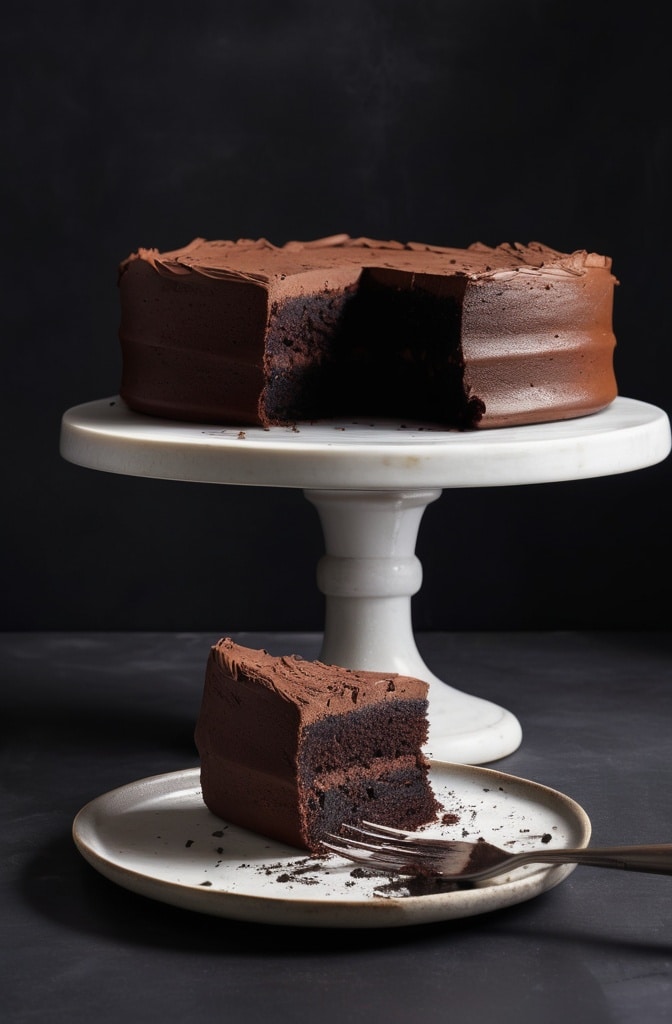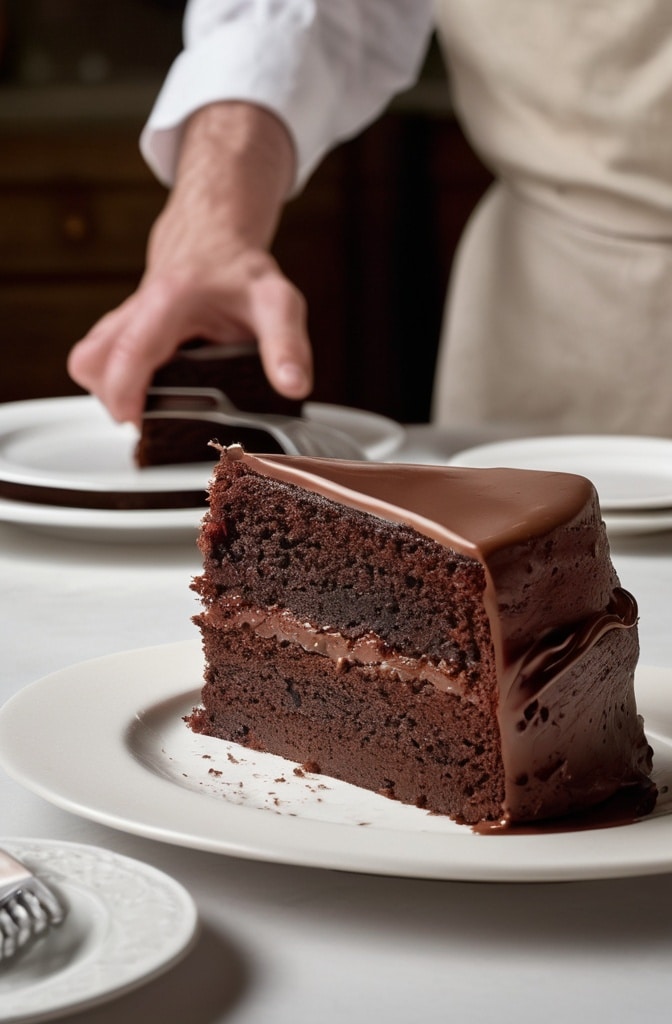The first time I encountered a genuine Decadent Italian Chocolate Cake, a traditional Torta al Cioccolato, in a small Florentine pastry shop, I nearly wept. It wasn’t the jetlag or the three espressos I’d consumed that morning it was the impossibly rich, almost provocatively intense chocolate flavor that seemed to whisper secrets of generations past. This cake, my friends, is not your standard chocolate dessert.
Italian chocolate cake traditions stretch back centuries, with each region adding their own subtle twists to the formula. What makes these cakes so special? It’s their unapologetic dedication to chocolate purity, their perfect moisture balance, and their surprising lightness despite the decadence.
Today, I’m sharing my meticulously perfected recipe for Torta al Cioccolato a chocolate cake that has made grown men propose marriage and pastry chefs demand my secrets. The beauty lies in its balance: intense chocolate notes harmonize with subtle hints of espresso and Amaretto, while maintaining a crumb structure that somehow manages to be both delicate and substantive.
Ingredients & Substitutions
For the Cake Base:
- 250g high-quality dark chocolate (70% cacao minimum), roughly chopped
- 175g unsalted European-style butter, softened, plus extra for greasing
- 5 large eggs, separated and at room temperature
- 150g granulated sugar, divided
- 1 tbsp instant espresso powder
- 2 tbsp Amaretto liqueur (or 1 tsp almond extract)
- 1 tsp genuine vanilla extract (not imitation)
- 1/4 tsp sea salt
- 100g almond flour, sifted
- 50g all-purpose flour, sifted
- 1/2 tsp baking powder
For the Chocolate Glaze:
- 150g high-quality dark chocolate (60-65% cacao)
- 120ml heavy cream
- 30g unsalted butter
- 1 tbsp corn syrup (prevents crystallization)
- Pinch of flaky sea salt
For Garnish (Optional):
- Fresh raspberries or cherries
- Gold leaf flakes
- Lightly toasted sllivered almonds
- Powdered sugar for dusting
The chocolate selection is absolutley crucial—I recommend Valrhona, Amedei, or Domori for their complex flavor profiles. If your budget doesn’t permit these, look for chocolate with bean-to-bar production methods rather than commercial brands. Trust me, the difference is staggering.
For a gluten-free variation, replace the all-purpose flour with an equal amount of almond flour or a high-quality cup-for-cup gluten-free blend. The texture will be slightly denser but equally satisfying.
Dairy-free bakers can substitute the butter with coconut oil (use 15% less by weight) and the heavy cream with full-fat coconut cream. The flavor profile shifts slightly toward the tropical, which actually complements the dark chocolate beautifully.
Step-by-Step Instructions

Preparation
- Preheat your oven to 170°C (335°F). Butter a 23cm (9-inch) springform pan, then line the bottom with parchment paper. Dust the sides with a mixture of cocoa powder and sugar rather than flour—this prevents the unsightly white edges many cakes suffer from.
- Set up a bain-marie (water bath) by placing a heatproof bowl over a saucepan of barely simmering water. The water shouldn’t touch the bottom of the bowl, as direct heat will compromise the chocolate’s texture. Patience here is fundamental.
- Create your mise en place by measuring and organizing all ingredients before starting. Temperature control is critical in chocolate work—cold ingredients meeting melted chocolate can cause disastrous seizing.
The Cake Batter
- Melt the chocolate and butter in your prepared bain-marie, stirring occasionally with a silicone spatula. The common mistake here is overheating—chocolate should never exceed 54°C (130°F). Once mixture is smooth and glossy, remove from heat and let cool slightly while you prepare the other components.
- In a medium bowl, whisk together the egg yolks with half the sugar (75g) until pale and thickened. You’re looking for the “ribbon stage”—when the mixture falls from the whisk, it should briefly hold its shape on the surface before sinking in. Gently fold in the cooled chocolate mixture, espresso powder, Amaretto, vanilla, and salt.
- In a separate, scupulously clean bowl, whip the egg whites on medium speed until foamy. Gradually add the remaining sugar (75g) while increasing to high speed, continuing until you achieve soft peaks that just hold their shape but still look moist. If you over-whip to stiff peaks, you’ll lose crucial air when folding.
- Combine the almond flour, all-purpose flour, and baking powder, then sift this mixture directly over the chocolate base. Fold gently using a large metal spoon or flexible spatula, using a J-motion from the bottom up. After incorporated, add one-third of the egg whites and fold to lighten the batter. Add remaining whites in two additions, folding just until incorporated—some streaks are preferable to overmixing.
- Pour the batter into your prepared pan, smoothing the surface with minimal manipulation. Bake in the center of your preheated oven for 30-35 minutes, or until the cake has risen and the center feels set but still yields slightly to a gentle touch. A toothpick inserted 2cm from the edge should come out mostly clean, but the very center should remain moist.
- Cool in the pan for exactly 10 minutes (set a timer), then carefully run a thin knife around the edges before releasing the springform. Let cool completely on a wire rack before glazing. For optimal texture development, wrap in parchment and rest overnight—the waiting is tortuous but transformative.
The Chocolate Glaze
- Place the chocolate for the glaze in a heatproof bowl. In a small saucepan, bring the cream just to a simmer—watch carefully, as cream can boil over in seconds.
- Pour the hot cream over the chocolate and let stand for 2 minutes without disturbing—this initial melting period is non-negotiable. Then stir gently from the center outward until smooth. Add the butter and corn syrup, stirring until fully incorporated and glossy.
- Allow the glaze to cool until it reaches a pourable consistency—around 35°C (95°F). If you rush this step, the glaze will run straight off the cake; too cool, and it won’t settle smoothly. Position the cooled cake on a rack over a baking sheet to catch drips.
- Pour the glaze in a single, confident motion starting from the center of the cake. Use an offset spatula to guide it over any bare spots if necessary. Finish with a sprinkle of flaky sea salt for that professional contrast of flavors. Allow the glaze to set at room temperature for at least 1 hour before garnishing or serving.
Cooking Techniques & Science
The molecular magic happening in this cake deserves appreciation. First, the separation and treatment of eggs is crucial—yolks provide richness and emulsification, while properly whipped whites create the cake’s structure without relying heavily on flour. This is why Italian chocolate cakes often achieve that paradoxical dense-yet-light texture.
The melting method matters tremendously. Chocolate contains cocoa butter crystals in various forms (polymorphs), and gentle melting preserves the most stable form (Form V), which gives properly tempered chocolate its characteristic snap and mouthfeel. Excessive heat damages these crystals irrevocably.
The inclusion of espresso isn’t merely for flavor—coffee compounds actually enhance the perception of chocolate, activating similar taste receptors and creating a more complex sensory experience. At the molecular level, they’re having quite the party.

Almond flour contributes not only flavor but moisture retention due to its higher fat content and lack of gluten. This prevents the cake from drying out and creates that coveted “melt-in-your-mouth” quality that distinguishes exceptional chocolate cakes.
The baking temperature is specifically calibrated for chocolate-heavy batters. Too hot, and the exterior sets before the interior can rise properly, resulting in a cracked surface. At 170°C, we achieve the perfect balance of gentle rising and moisture retention.
Serving & Pairing Suggestions
This torta shines brightest when served at room temperature—cold dulls its flavors while excessive heat turns the texture sad and overly soft. If refrigerated, allow at least 30 minutes of countertop time before serving.
For an elevated presentation, place a single raspberry in the center surrounded by a tiny halo of fresh mint leaves and a whisper of gold leaf. Alternatively, create a fan of three thin orange slices, lightly caramelized with a kitchen torch for dramatic effect.
The traditional Italian accompaniment is a small glass of Vin Santo or Amaretto, but I find a properly pulled espresso creates the most harmonious flavor bridge. For non-alcoholic pairings, a blood orange sparkling water offers refreshing contrast.
This cake becomes the cornerstone of a sophisticated dessert spread when paired with light, contrasting offerings. Consider serving alongside panna cotta with seasonal fruit, or a small scoop of fior di latte gelato for temperature and textural variation.
Conclusion
What elevates this Torta al Cioccolato beyond ordinary chocolate cakes is its thoughtful balance of intensity and elegance. It refuses to overwhelm with sweetness, instead offering layers of complex chocolate notes that reveal themselves gradually with each bite.
The most common pitfall when executing this recipe is impatience—rushing the melting, the folding, or the cooling will compromise your results. Instead, approach each step with intention and respect for the ingredients. Chocolate responds to gentle, attentive handling.
Remember that humidity affects chocolate work dramatically—on very damp days, consider running a dehumidifier in your kitchen if available. And if disaster strikes (it happens to everyone), broken cakes make exceptional trifles or can be reborn as truffles.
This cake represents the soul of Italian dessert philosophy: exceptional ingredients, minimal interference, maximum pleasure. It’s a celebration of chocolate in its most honest, dignified form.
FAQs About Decadent Italian Chocolate Cake
Can I make this cake ahead of time?
Absolutley. In fact, the cake improves with 24 hours of rest, as the flavors meld and deepen. Store at room temperature under a cake dome for up to 3 days, or refrigerate for up to a week. If refrigerating, be sure to bring back to room temperature before serving.
Why did my cake sink in the middle?
A slight depression is actually characteristic of this style of cake due to its relatively low flour content. However, dramatic sinking usually indicates underbaking or opening the oven door too early in the baking process. The delicate air structure needs time to set before being subjected to temperature changes.
Can I freeze this cake?
Yes, but freeze it unglazed. Wrap the completely cooled cake tightly in plastic wrap, then aluminum foil, and freeze for up to 3 months. Thaw overnight in the refrigerator, then bring to room temperature before glazing. The texture remains remarkably good.
My chocolate seized when melting. Can I save it?
If your chocolate becomes grainy or stiff during melting, you can often rescue it by immediately adding 1-2 teaspoons of neutral vegetable oil and stirring vigorously over low heat. Prevention is better than cure—ensure all equipment is completely dry and avoid even tiny drops of water.
What’s the best way to slice this cake neatly?
For professional-looking slices, dip a sharp knife in hot water, wipe clean, then slice in a single, deliberate motion. Clean and reheat the knife between each cut. For special occasions, I use unflavored dental floss held taut between both hands to create incredibly clean cuts.

